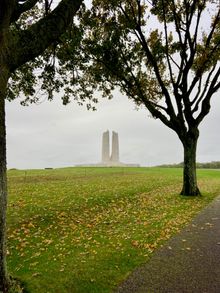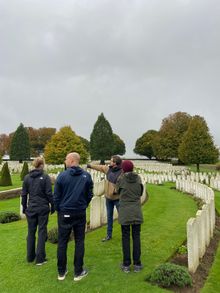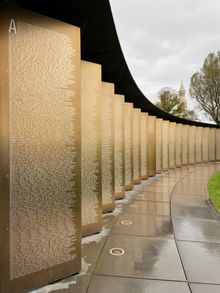 19 Nov 2024
19 Nov 2024
The Northern French town of Arras and its surrounding Pays d’Artois are strewn with an extraordinary number of memorial sites from the First World War, having harboured so many battlefields at the heart of the Battle of Arras in 1917. All sites are within a short drive of each other, but it’s by getting up close on foot and walking around them that we can truly appreciate their scale and poignancy. Many of the smaller sites are also linked by a new 26-kilometre cycle route, the ‘Bataille d’Arras’. Arras offers excellent accessibility from the UK via Eurostar, Eurotunnel or ferry.
A collaboration between the tourist offices of Arras-Pays d’Artois and Lens-Liévin, ‘Collines et Plaines d’Artois’ (‘Artois Hills and Plains’) is an initiative following the traces of the Great War, combining history, hikes and memorable experiences. The Front Line passed through both territories during the war and 13 of the 36 major sites on the Remembrance Trails lie between Loos-en-Gohelle (to the north of Lens) and Serre-les-Puisieux (to the south of Arras).
The top Arras memorial sites to see on foot
The French National Necropolis and Ring of Remembrance at Notre-Dame-de-Lorette
This is the largest French war cemetery, built on the site of battles that took place in May 1915, with 20,000 individual graves and the bodies of 22,000 other unknown soldiers laid to rest in ossuaries. Also at Notre-Dame-de-Lorette, the Ring of Remembrance by Philippe Prost is a must-see monument shaped as a vast ellipsis engraved with 580,000 fallen soldiers’ names. For the first time, they are listed alphabetically with no distinction between nationality, rank, gender or religion. The Ring has a circumference of over 345 metres, with the 56 metres hanging over the side of the hill reminding us of the fragile balance of the newfound peace.
The Canadian National Memorial at Vimy
Vimy is considered the birthplace of modern Canada; it was after the Battle of Vimy Ridge, won in April 1917 by Canadian divisions fighting together for the first time, that these soldiers developed a strong sense of belonging to the same nation. The National Vimy Commemorative Park attracts 200,000 visitors every year, who come to marvel at the scale of the gleaming white monument and walk around the reconstructed trenches. The monument is printed on today’s Canadian 20-dollar note, surrounded by poppies.
Le Monument des Fraternisations
The ‘Monument to the Fraternisations’ is a central site memorialising the Great War in the Pays d’Artois. Inaugurated in 2015, it owes its existence to the determination of Corporal Louis Barthas, who was involved in fraternisations with the enemy at this very spot in 1915. Bunkered in their respective trenches and exhausted by the cold and fighting, French and German soldiers left the safety of their shelters and fraternised with their adversaries. Thousands of truces were declared at Christmas, when the men sang together and swapped tobacco and drinks: a powerful symbol of humanity.
La Maison Blanche, the German War Cemetery
The largest German war cemetery in France, also at Neuville-St-Vaast, this is the final resting place for 44,833 German soldiers, of which 8,040 were never identified and buried in a common grave. Most of the soldiers died in the intense fighting in Artois, on Lorette Spur (1914-1915) and Vimy Ridge (1917-1918). The Treaty of Versailles provided for the shared maintenance of war cemeteries and so, in 1922, France granted her 'ex-enemies' who fell on her soil the right in perpetuity to a grave.
The Arras memorial sites you can visit by bike
The 26-kilometre ‘Bataille d’Arras’ cycle route, signposted as Route H1, opened in 2023 and takes you on an alternative tour of lesser-known sites linked to the Battle of Arras. These sites don’t feature in history books, but nevertheless left an indelible mark on the region and its people and landscapes. Departing from the Wellington Quarry, the route passes 17 sites as it weaves its way through the Artois villages of Tilloy-les-Mofflaines and Monchy-le-Preux and their countryside, skirting fields of crops and bright sunflowers.
Ten of the sites are dedicated to British troops, with three of these specifically Scottish – the Level Crossing site, Seaforth Highlanders site and Point du Jour – and another an individual memorial to British soldier Lieutenant Henri Roland Isaacs. Of particular note are the Newfoundland Memorial in Monchy featuring a proud bronze caribou, and the British 37th Division Monument, marked by a sculpture of three soldiers leaning against each other to rest by Lady Feodora Gleichen, sister of a former commander of this unit and the first woman to be admitted to the Royal Society of British Sculptors. Electric and non-electric bikes can be hired from the Arras Tourist Office (situated in the Hôtel de Ville on Place des Héros) or from the Riverside Park Leisure Centre in Saint-Laurent-Blangy. View the route map and stages on Cirkwi.
Arras’ other top (indoor) memorial sites
The Carrière Wellington (Wellington Tunnels)
Memorial to the Battle of Arras and New Zealand Tunnelling Company, the Wellington Tunnels offer insight into the preparation for the Battle of Arras and how it unfolded. This site of old underground chalk tunnels, where 24,000 soldiers lived, reopened three years ago following major renovation. New technologies enhance the sensory and emotional experience, with video mappings projected directly onto the chalk walls and 3D audio techniques. Visits use a combination of guide presentation and audioguides.
The Commonwealth War Graves Commission (CWGC)
The CWGC Experience is a unique interpretation centre offering the visitor an insight into the behind-the-scenes work of the Commonwealth War Graves Commission in nearby Beaurains. This organisation honours the memory of the military service of men and women of the Commonwealth countries who fell in the two World Wars, maintaining their graves and memorials in over 150 countries and territories.
Bullecourt 1917: The Musée Jean & Denise Letaille
The result of a lifetime spent collecting military objects gleaned from the fields around Bullecourt, the moving Jean & Denise Letaille Museum draws us into the personal stories behind the British and Australian soldiers involved in the Battle of Arras. History is made tangible through the personal items on display, with the golden voice of Jean Letaille himself accompanying visitors at this emotionally charged site. The five Australian divisions involved suffered almost 10,000 casualties.
-ENDS-
Further information
Browse the Arras Essentials press kit
Visit the Arras-Pays d’Artois website






